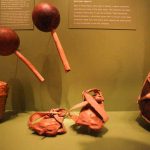Taino heritage in Caribbean
 New exhibit explores Taino heritage in the Caribbean
New exhibit explores Taino heritage in the Caribbean
BY ALEXANDRA SIMON From Caribbean Life
Tradition in gear: A Taino head dress, foreground, and instrument in the background, on display at the National Museum of the American Indian’s new exhibit “Taino: Native Heritage and Identity in the Caribbean.”
The National Museum of the American Indian is opening a new exhibit about the indigenous Tainos on July 28. The display titled “Taino: Native Heritage and Identity in the Caribbean,” explores the history of the indigenous peoples before, during, and after European colonization. One of the focal points of the presentation examines the group mostly in parts of the Spanish-speaking Caribbean, what makes someone Taino, and the advocacy for Taino identity, said the curator.
“We talk about the living legacy of the indigenous people generally and how its in the culture of all Caribbean people regardless of whether or they’re Taino, because it’s something that’s part of everybody’s legacy,” said Ranald Woodaman. “But we’re also trying to make context for the Taino movement itself since it emerged around 40 years ago, and a lot of people may not know where it came from.”
The burgeoning movement has inspired an increased interest in revisiting the indigenous heritage of the Caribbean, and with the launch of this exhibit, a lot of pressing questions will be answered, added Woodaman.
“What we’re trying to do is make sense of that to people and show them why and where this movement came from,” he said. “There’s people with these family stories and even though the indigenous history is not always there, we want to try and build context for it so people can understand and are respectful to the movement.”
The multi-room exhibit features images, paintings, artifacts, maps, and even video footage detailing and discussing who are the Taino, their way of life, and how their customs and traditions still lives on in their descendants and the existing populations in the Caribbean.
One of exhibit’s display showcases the number of foods and crops the Taino harvested, and how the names of them either stayed the same or evolved with colonization. Such an example is batata, which is a Taino word for sweet potato, or guayabo, which is now commonly referred to as guava.
Other parts of the exhibit detail the exchanges between indigenous people and Africans, some who came as slaves and others as free people, and how Black Caribs and Garifuna came to be.
While there is a strong focus on indigenous identity in Puerto Rico, Dominican Republic, and Cuba, there is mention of Haiti in particular, which shares the island of Hispaniola with neighboring Dominican Republic. Woodaman says both Haiti and Jamaica also have strong Taino roots, but their connection to it vastly differs from how Spanish-speaking countries.
“The sugar economy was ramped up in Haiti and Jamaica sooner than the rest of the Spanish- speaking Caribbean and that also meant those places had many more enslaved Africans coming,” said Woodaman.
As a result, their identities leans more towards their African heritage, with several remnants of the Taino in ancestral and traditional practices.
“In Haiti and Jamaica, there’s a lot of ideas of black nationalism interwoven into their consciousness but the connection is there just not as strong and different,” he said.
“In Jamaica, it’s the Maroons and how they honor those ancestors, and in Haiti, Vodun has Taino elements and Haiti named itself after the native name of the island.”
Woodaman said the goal of the exhibit was to shed light on the Taino heritage, the movement that has grown stateside, and how their traditions can help modern times.
“People should come because indigenous knowledge is still valuable to the present and may in fact offer some incredible solutions to the Caribbean, especially when we think about things like post-Maria,” he said.
“Taino: Native Heritage and Identity in the Caribbean” at National Museum of the American Indian [1 Bowling Green at State Street in Financial District, (212) 514-3700, www.nmai.si.edu]. On display July 28 through Oct. 2019.
IMAGES:
All Photos by Jason Speakman
EVOLUTION: The exhibit features dozens of intricately designed artifacts that Taino used.
Taino pottery often depicted faces.
ONE TEXTURE FITS ALL: A Taino instrument, now commonly referred to as maracas, and other items often made from the same material
INDIGENOUS HERITAGE: The multi-room exhibit has more than a dozen different pieces of artifacts.
OLD AND MODERN: The juxtaposition of ancient Taino art, and skateboard design featuring elements of indigenous art.
EVOLUTION: The exhibit features dozens of intricately designed artifacts that Taino used.









